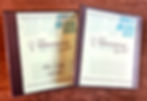How to set up an Enrichment Binder for Upper Elementary Students
- Janis Lodge
- Jul 31
- 4 min read
Updated: Aug 2
The idea of Enrichment Binders came from a need to provide meaningful, low-prep academic enrichment to upper elementary students. I was creating activities, projects, and special assignments for students that needed enrichment, but we didn’t have an organized system to keep everything in a specific place.
Enrichment Binders solved that problem. These organized, ready-to-go binders promote independent learning, and keep gifted or early-finisher students engaged—all without scrambling to find an activity on the fly. Whether you're a classroom teacher wanting to weave in weekly enrichment or a gifted education teacher working with small pull-out groups, Enrichment Binders make it easy to differentiate and challenge students consistently.

Why Enrichment Binders Matter
Every classroom has students who crave more depth, more challenge, or a new way to apply their learning. Enrichment Binders empower students to take ownership of their thinking and stretch their minds across subjects. They’re especially valuable for:
Gifted learners who need more than just “extra work”
High-achieving students ready for independent challenge
Early finishers who would benefit from meaningful extension tasks
Teachers who want to offer enrichment without prepping something new every week

These binders are structured, yet flexible—and once they're set up, they become a yearlong resource you can reuse again and again.
Supplies You’ll Need
To create your Enrichment Binders, here’s what you’ll need:
For each student:
1” binder (You can buy these in bulk at a discount!)
5-tab binder dividers (You can buy these in bulk at a discount!)
Cardstock for sturdy covers or task cards
For the teacher version (master binder):
1.5” binder (larger size)
Lesson plans or pacing guide (Here's a FREE "First 4 Weeks Planning Guide")
Master Copies and completed student sample pages
Answer keys (if applicable)
Notes for differentiation or extension ideas
What to Include in Each Section
Each binder has five sections that rotate through weekly activities. These can be added gradually or pre-filled with a semester’s worth of resources. I have created many of these elements already, so save time and use mine! Here’s a quick look at what to include:

Depth & Complexity
Use this section to introduce students to critical thinking tools like the Depth & Complexity Icons. You can include:
Depth & Complexity Prompt of the Week Activities
Graphic organizers using icons (e.g., "Multiple Perspectives" or "Big Idea")
Open-ended task cards that connect to content areas
Critical Thinking
This section is ideal for logic puzzles, brainteasers, or creative challenges.
Deductive reasoning Logic Puzzles
“Which One Doesn’t Belong” open-ended puzzles
Strategy-based games or activities
Reading Enrichment
Offer tasks that deepen reading comprehension and interpretation.
Close reading passages with layered questions (I like to incorporate Depth & Complexity Annotations & Questions)
Mini literary analysis with icons or Socratic-style questions

Writing Enrichment
Encourage students to write across genres while connecting with deeper thinking.
Creative Emoji Writing prompts
Quick-writes with critical thinking stems
Scholarly reflections
STEM/ Projects
Great for hands-on learners and project-based thinkers.
Quick STEM challenges (e.g., build a tower using only straws and tape)
Mini project prompts with planning sheets
Market Day, Rube Goldberg Challenges, and elaborate Marble Runs

How to Use Enrichment Binders in the Classroom
You can implement these binders flexibly depending on your classroom model:

In a General Education Classroom:
Choice Time or Early Finisher Work: Students who complete core assignments can move on to a meaningful enrichment task from their binder.
Weekly Enrichment Block: Dedicate one period per week to enrichment, allowing all students access to high-level thinking activities.
Small Group Rotations: Use during literacy or math centers for students who need more advanced tasks or differentiated instruction.
Homework or Independent Study Option: Send home selected pages to extend learning beyond the classroom.
In a Pull-Out Gifted Program:
Organized Lesson Flow: Begin each pull-out session with a warm-up (Critical Thinking or Depth & Complexity), followed by a deep dive into Reading or Writing Enrichment, and wrap up with a collaborative or creative STEM challenge.
Individual Binders or Portfolios: Each student keeps their own binder, allowing teachers to track progress over time and differentiate tasks based on readiness and interest.
Flexible Grouping: Activities are open-ended and easily adaptable for small groups or independent work, supporting both collaborative learning and individual pacing.
Minimal Prep: Ready-to-go pages allow gifted specialists to focus on facilitation, questioning, and extending learning—not prepping materials every week.
For Homeschooling Families:
Structure your week by rotating through each section
Use completed pages for portfolio documentation
Allow choice and autonomy by letting students pick tasks from each category
Let's Set Up Some Enrichment Binders!
Enrichment Binders are more than just worksheets in a binder. They’re a powerful tool to build independence, creativity, and critical thinking in your upper elementary learners. Once set up, they’ll save you time while enriching your students' academic journey in meaningful ways.
Whether you're supporting gifted learners, offering tiered extensions, or simply wanting to provide more challenge in your classroom—this is a system you’ll be glad you have in place. Save time, and use the Enrichment Binder resources that I've already created!



